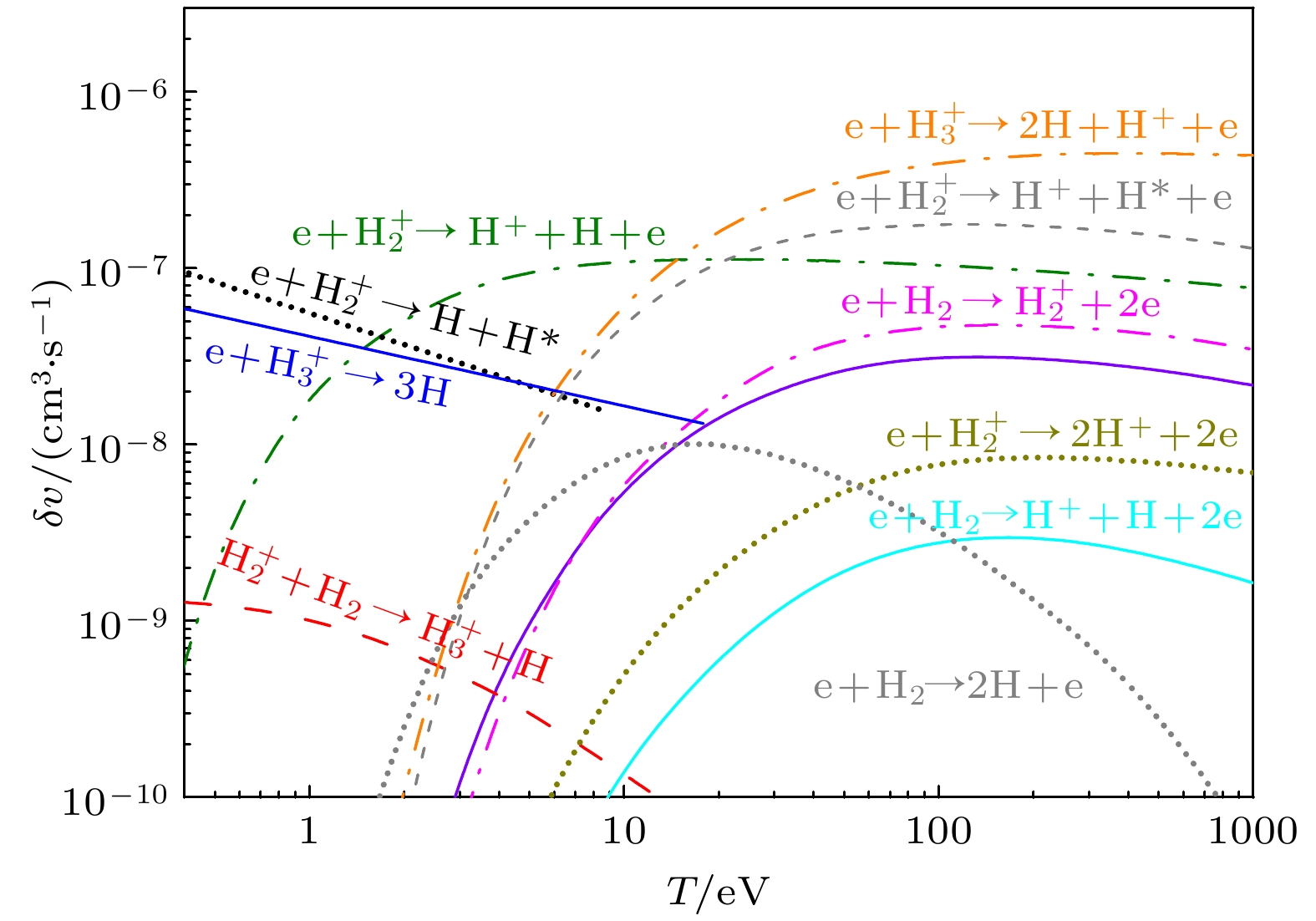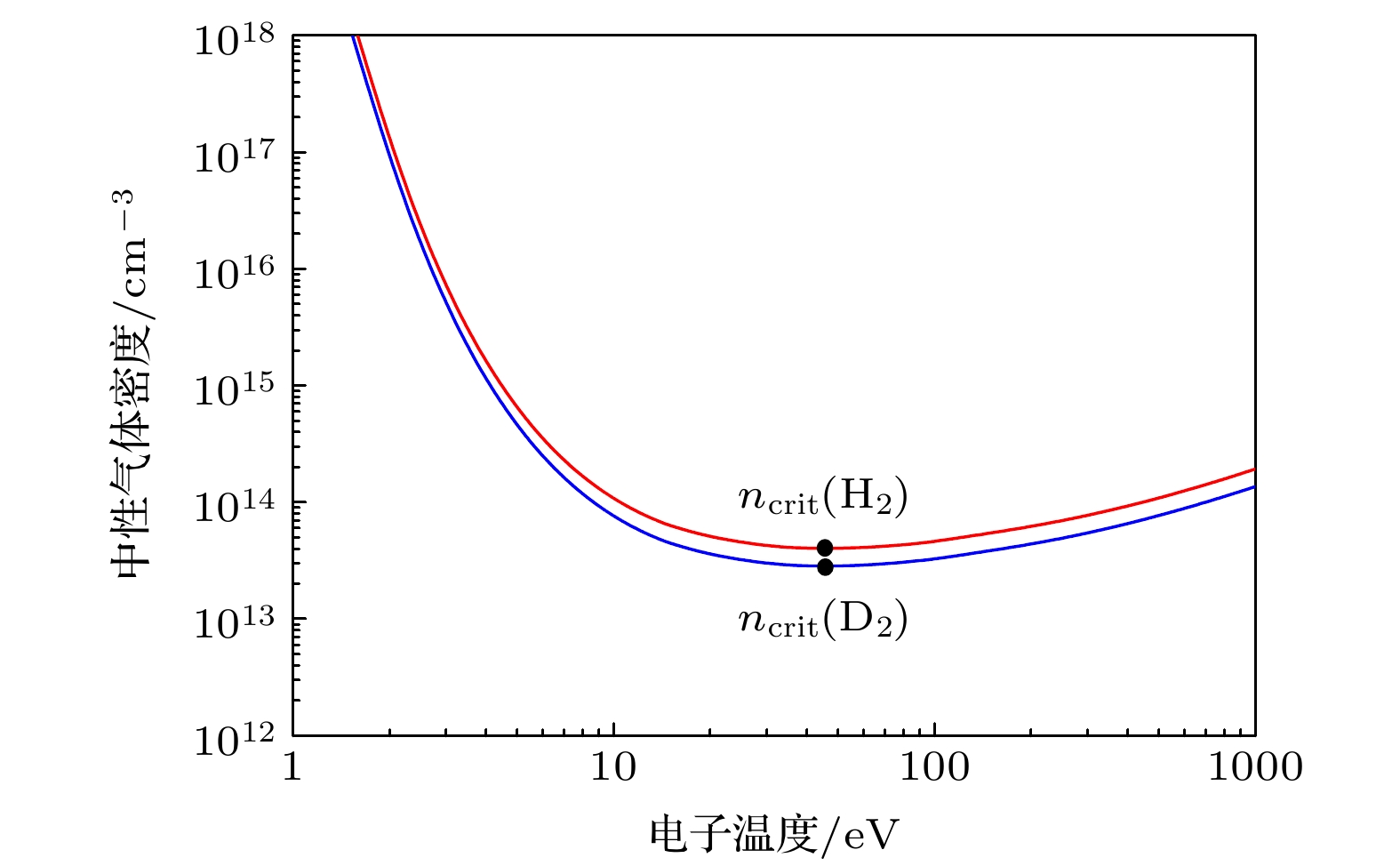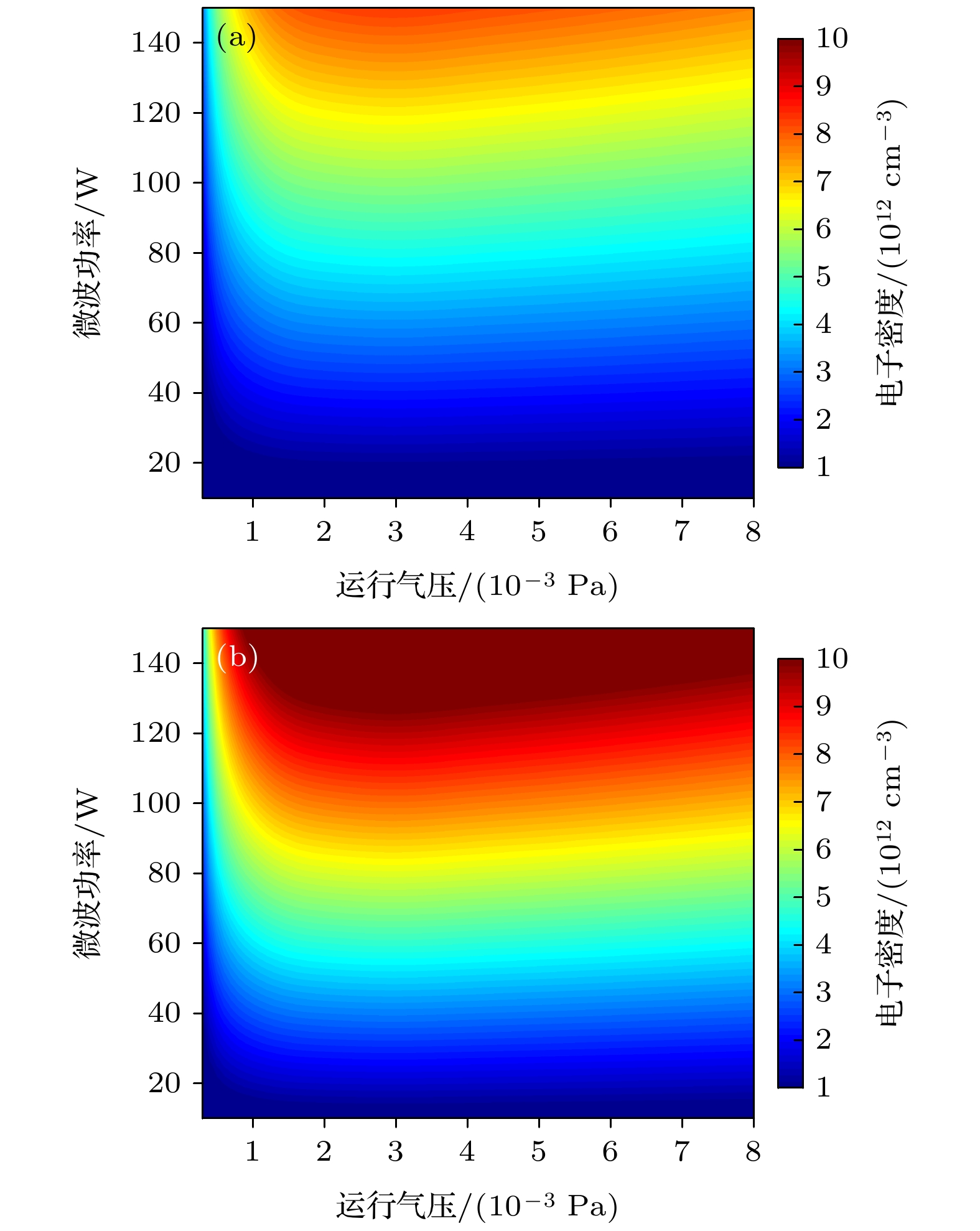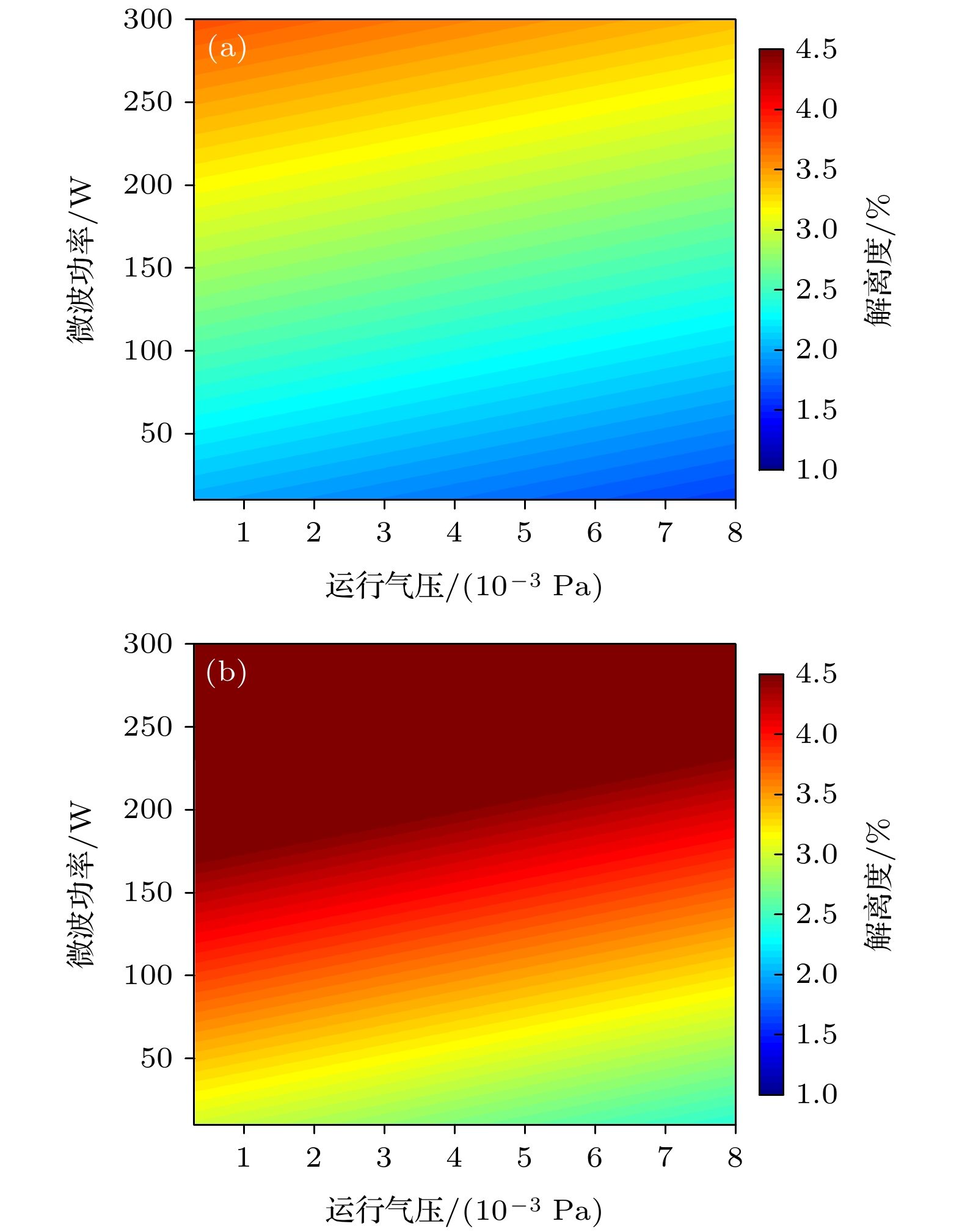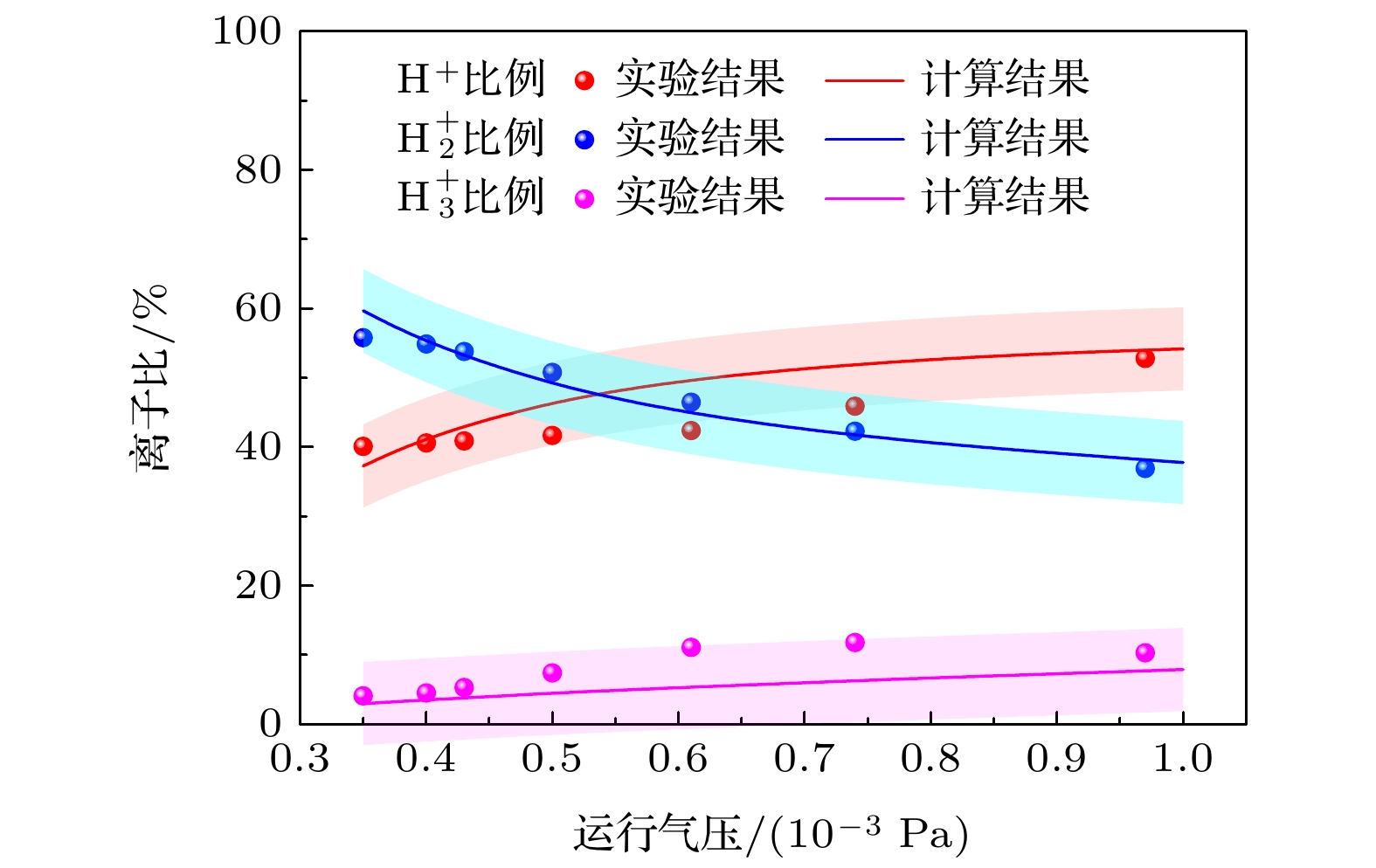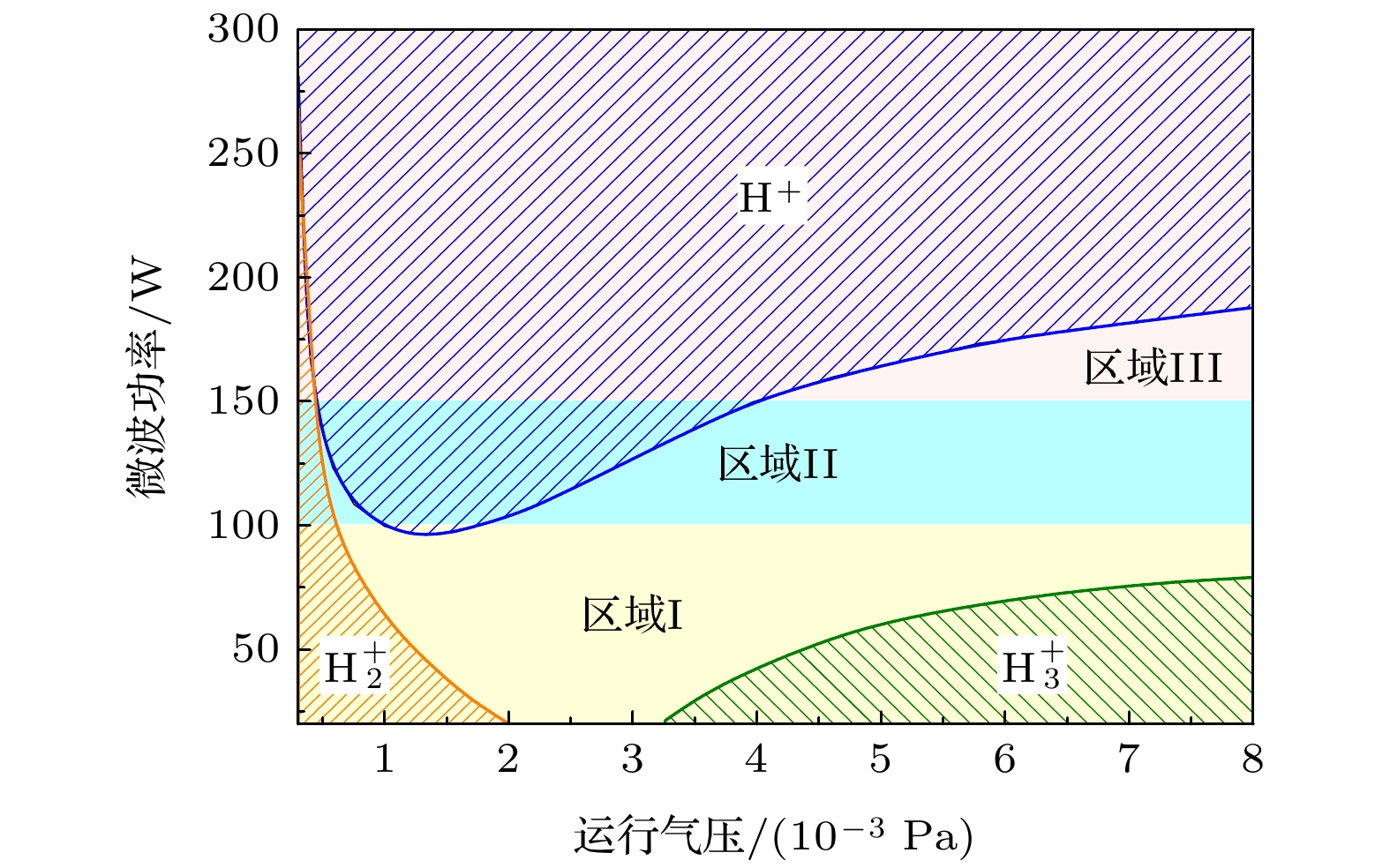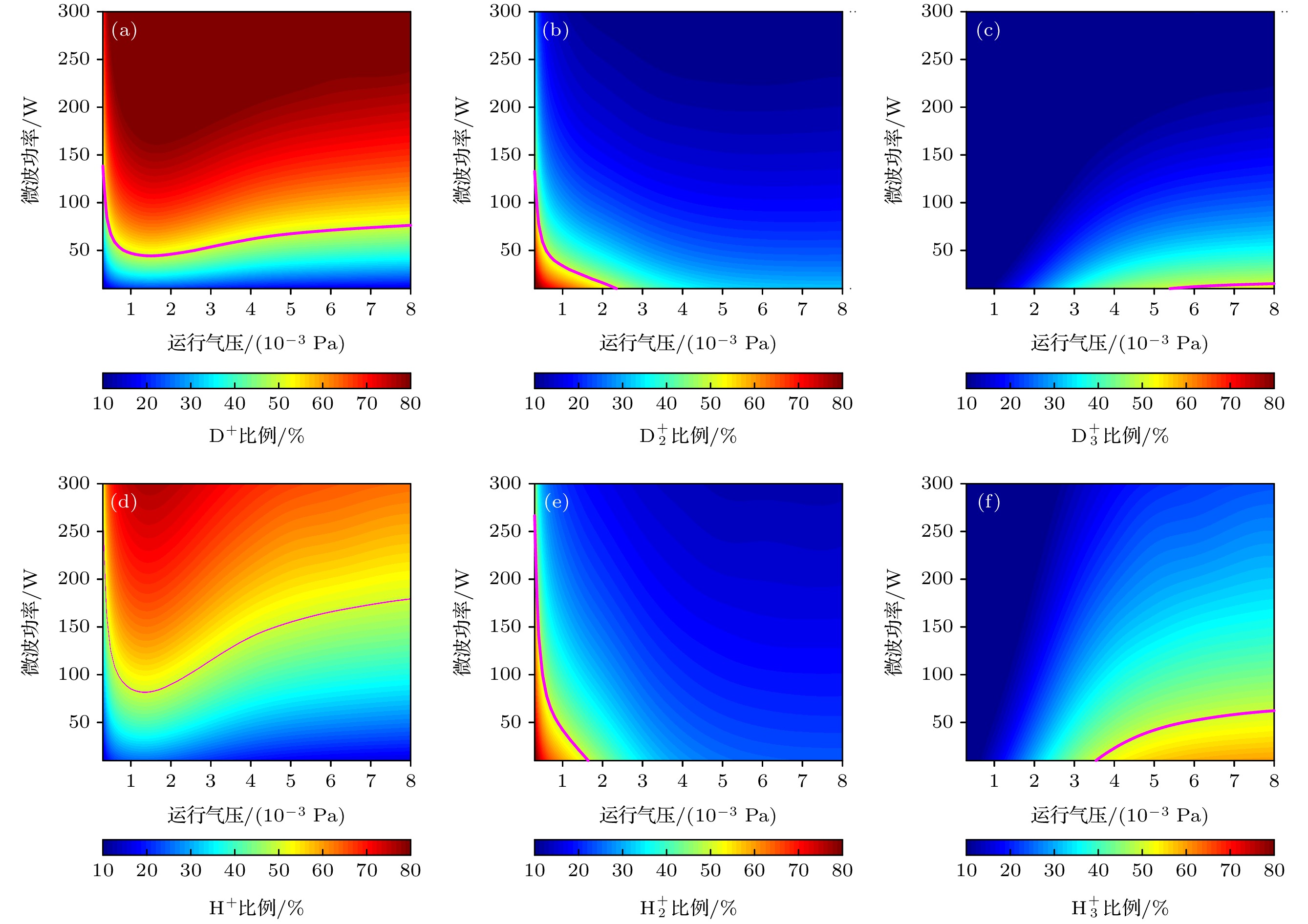-
微型电子回旋共振(electron cyclotron resonance, ECR)离子源在紧凑型离子注入机、小型中子管、微型离子推进器等领域有着十分广泛的应用. 为了深入认识微型ECR离子源的工作机理, 本文以北京大学自主研制的一款微型氘离子源作为研究对象, 以氢气和氘气放电形成的等离子体为例, 发展了一种基于粒子平衡方程的全局模型. 研究结果表明, 该离子源束流成分与离子源的运行气压和微波功率有着很强的依赖关系. 对于氢气放电等离子体, 微波功率低于100 W时, 离子源可以分别在低气压和高气压情况下获得离子比超过50%的
$ {\text{H}}_2^ + $ 离子束和$ {\text{H}}_3^ + $ 离子束; 当微波功率高于100 W时, 可以在很宽的运行气压范围内, 获得质子比超过50%的束流. 因此, 提高微波功率是提高微型离子源质子比的关键. 对于氘气放电等离子体, 3种离子比例对运行气压和微波功率的依赖关系与氢气放电等离子体的规律基本一致. 但是在相同的运行条件下, D+比例比H+比例高10%—25%. 也就是说, 在微型氘离子源的测试和优化过程中, 可以利用氢气代替氘气进行实验, 并将质子比测量结果作为相同条件下氘离子比例的下限.Miniature electron cyclotron resonance (ECR) ion sources are widely used in compact ion implanters, miniature neutron tubes, and miniature ion thrusters. To understand the mechanism of miniature ECR ion source, a miniature deuterium ion source developed by Peking University is taken as the research object. In this work, a global model based on particle balance equations is developed for studying the hydrogen plasma and the deuterium plasma inside the miniature ECR source. The research results show that both the hydrogen discharge process and the deuterium discharge process of the ion source are strongly dependent on the gas pressure and microwave power. The calculated results show that high power is beneficial to increasing the proportion of H+(D+) ions, low pressure is helpful in augmenting the ratio of$ {\text{H}}_2^ + $ ($ {\text{D}}_2^ + $ ) ions, high pressure and low power are beneficial to enhancing the proportion of$ {\text{H}}_3^ + $ ($ {\text{D}}_3^ + $ ) ions. In addition, there is a large difference in ion proportion between hydrogen discharge and deuterium discharge. Under the same operating parameters, the proportion of D+ ions is 10%–25% higher than the proportion of H+ ions since the plasma density of deuterium discharge is higher than that of hydrogen plasma. Therefore, during the operation of miniature source, H2 gas, instead of D2 gas, can be used in experiment, and the proportion of D+ ions under the corresponding operating parameters can be estimated based on the proportion of H+ ions. Finally, the calculated results show that high microwave power is a prerequisite for achieving the high proportion of H+ (D+) ions. However, owing to the limitation of microwave coupling efficiency, the miniature ECR ion source cannot work when the microwave power is greater than 150 W, so that the H+ (D+) proportion cannot be further increased, thereby limiting its further applications in neutron sources, implanters, etc. Therefore, how to improve the microwave coupling efficiency has become one of the key research contents of the miniature ECR ion source. The global model proposed in this paper is helpful in understanding the physical process of the miniature ECR ion source, but there are also some shortcomings. Firstly, the effect of the secondary electron emission coefficient is not considered in the model, so it is impossible to study the influence of wall materials on ion proportion in detail. Secondly, the dissociation degree depends on the plasma measurements, and the error of plasma measurements in turn affect the accuracy of the model to a certain extent. In addition, only the hydrogen plasma model and deuterium plasma model are established in this work, based on which it is impossible to study the processes of other gas discharge plasmas. In the future, the above factors will be considered and the model will be further improved to establish a complete and self-consistent global model of the miniature ECR ion source.-
Keywords:
- electron cyclotron resonance ion source /
- plasma simulation /
- ion fraction /
- neutron source
[1] Gammino S, Celona L, Ciavola G, Maimone F, Mascali D 2010 Rev. Sci. Instrum. 81 02B313
 Google Scholar
Google Scholar
[2] 丁俊章, 赵玉彬, 刘占稳, 赵红卫, 袁平, 曹云, 雷海亮, 张子民, 张雪珍, 张汶, 郭晓虹, 王辉, 冯玉成, 李锦玉, 马保华, 高级元, 宋沛, 李锡霞 2001 核技术 24 43
 Google Scholar
Google Scholar
Ding J Z, Zhao Y B, Liu Z W, Zhao H W, Yuan P, Cao Y, Lei H L, Zhang Z M, Zhang X Z, Zhang W, Guo X H, Wang H, Feng Y C, Li J Y, Ma B H, Gao J Y, Song P, Li X X 2001 Nucl. Tech. 24 43
 Google Scholar
Google Scholar
[3] Alonso J R, Calabretta L, Campo D, Celona L, Conrad J, Martinez R G, Johnson R, Labrecque F, Toups M H, Winklehner D, Winslow L 2014 Rev. Sci. Instrum. 85 02A742
 Google Scholar
Google Scholar
[4] 崔保群, 李立强, 包轶文, 蒋渭生, 王荣文 2002 原子能科学技术 36 486
 Google Scholar
Google Scholar
Cui B Q, Li L Q, Bao Y W, Jiang W S, Wang R W 2002 Atomic Energy Science and Technology 36 486
 Google Scholar
Google Scholar
[5] Harrison S E, Voss L F, Torres A M, Frye C D, Shao Q, Nikolić R J 2017 J. Vat. Sci. Technol. A 35 061303
 Google Scholar
Google Scholar
[6] More S E, Dave J R, Makar P K, Bhoraskar S V, Premkumar S, Tomar G B, Mathe V L 2020 Appl. Surf. Sci. 506 144665
 Google Scholar
Google Scholar
[7] Kim W J, Ryu J, Im J, Kim S H, Kang S Y, Lee J H, Jo S H, Ha B K 2018 Mol. Genet. Genomics. 293 1169
 Google Scholar
Google Scholar
[8] 李波, 刘华昌, 王云, 吴小磊, 李阿红, 瞿培华, 陈强, 樊梦旭, 巩克云, 欧阳华甫, 吴丛凤 2019 原子能科学技术 53 1656
 Google Scholar
Google Scholar
Li B, Liu H C, Wang Y, Wu X L, Li A H, Qu P H, Chen Q, Fan M X, Gong K Y, Ouyang H F, Wu C F 2019 Atomic Energy Science and Technology 53 1656
 Google Scholar
Google Scholar
[9] Jiang Y X, Peng S X, Wu W B, Ma T H, Zhang J F, Ren H T, Zhang T, Wen J M, Xu Y, Zhang A L, Sun J, Guo Z Y, Chen J E 2020 Rev. Sci. Instrum. 91 033319
 Google Scholar
Google Scholar
[10] Vainionpaa J H, Harris J L, Piestrup M A, Gary C K, Williams D L, Apodaca M D, Cremer J T, Ji Q, Ludewigt B A, Jones G 2013 AIP Conf. Proc. 1525 118
 Google Scholar
Google Scholar
[11] Fu S, Ding Z, Ke Y, Tian L 2020 IEEE T. Plasma. Sci. 48 676
 Google Scholar
Google Scholar
[12] Wen J M, Peng S X, Ren H T, Zhang T, Zhang J F, Wu W B, Sun J, Guo Z Y, Chen J E 2018 Chin. Phys. B 27 055204
 Google Scholar
Google Scholar
[13] Bogomolov S L, Bondarchenko A E, Efremov A A, Kostyukhov Y E, Kuzmenkov K I, Loginov V N, Pugachev D K, Fatkullin R D 2019 J. Instrum. 14 C01009
 Google Scholar
Google Scholar
[14] Ke Y J, Sun X F, Chen X K, Tian L C, Zhang T P, Zheng F M, Jia Y H, Jiang H C 2017 Plasma Sci. Technol. 19 095503
 Google Scholar
Google Scholar
[15] Yamamoto N, Chikaoka T, Masui H, Nakashima H, Takao Y, Kondo S 2006 In 42nd AIAA/ASME/SAE/ASEE Joint Propulsion Conference & Exhibit California, America, July 9–12, 2006 p5177
[16] Torii Y, Shimada M, Watanabe I 1992 Rev. Sci. Instrum. 63 2559
 Google Scholar
Google Scholar
[17] Ji Q 2011 AIP Conf. Proc. 1336 528
 Google Scholar
Google Scholar
[18] Baumgarten C, Barchetti A, Einenkel H, Goetz D, Schmelzbach P A 2011 Rev. Sci. Instrum. 82 053304
 Google Scholar
Google Scholar
[19] Fatkullin R, Bogomolov S, Kuzmenkov K, Efremov A 2018 EPJ Web of Conf. 177 08003
 Google Scholar
Google Scholar
[20] Chan C F, Burrell C F, Cooper W S 1983 J. Appl. Phys. 54 6119
 Google Scholar
Google Scholar
[21] Samuell C M, Corr C S 2016 Plasma Sources Sci. Technol. 25 015014
 Google Scholar
Google Scholar
[22] Zorat R, Goss J, Boilson D, Vender D 2000 Plasma Sources Sci. Technol. 9 161
 Google Scholar
Google Scholar
[23] Hollmann E M, Pigarov A Y 2002 Phys. Plasmas 9 4330
 Google Scholar
Google Scholar
[24] Ke J L, Liu Y G, Liu B L, Hu Y H, Liu M, Tang J, Zheng P, Li Y, Wu C L, Lou B C 2020 Instrum. Exp. Tech. 63 616
 Google Scholar
Google Scholar
[25] Svarnas P, Bacal M, Auvray P, Béchu S, Pelletier J 2006 Rev. Sci. Instrum. 77 03A512
 Google Scholar
Google Scholar
[26] Eguchi T, Sasao M, Shimabukuro Y, Ikemoto F, Kisaki M, Nakano H, Tsumori K, Wada M 2020 Rev. Sci. Instrum. 91 013508
 Google Scholar
Google Scholar
[27] Janev R K, Langer W D Jr, Evans K, Post D E 1987 Elementary Processes in Hydrogen-Helium Plasmas: Cross Sections and Reaction Rate Coefficients (Springer-Verlag Berlin Heidelberg) p1868
[28] Huh S R, Kim N K, Jung B K, Chung K J, Hwang Y S, Kim G H 2015 Phys. Plasmas 22 033506
 Google Scholar
Google Scholar
[29] McNeely P, Dudin S V, Christ-Koch S, Fantz U, the NNBI Team 2009 Plasma Sources Sci. Technol. 18 014011
 Google Scholar
Google Scholar
[30] Godyak V A, Piejak R B, Alexandrovich B M 2002 Plasma Sources Sci. Technol. 11 525
 Google Scholar
Google Scholar
[31] Singh S B, Chand N, Pati D S 2009 Vacuum 83 372
 Google Scholar
Google Scholar
[32] Kimura T, Kasugai H 2010 J. Appl. Phys. 107 083308
 Google Scholar
Google Scholar
[33] Hjartarson A T, Thorsteinsson E G, Gudmundsson J T 2010 Plasma Sources Sci. Technol. 19 065008
 Google Scholar
Google Scholar
[34] Fantz U 2006 Plasma Sources Sci. Technol. 15 S137
 Google Scholar
Google Scholar
[35] Mazzaglia M, Castro G, Mascali D, Celona L, Neri L, Torrisi G, Gammino S, Reitano R, Naselli E 2019 Phys. Rev. Accel. Beams 22 053401
 Google Scholar
Google Scholar
[36] Wu W B, Ren H T, Peng S X, Xu Y, Wen J M, Sun J, Zhang A L, Zhang T, Zhang J F, Chen J E 2017 Chin. Phys. B 26 095204
 Google Scholar
Google Scholar
[37] Koga M, Yonesu A, Kawai Y 2003 Surf. Coat. Tech. 171 216
 Google Scholar
Google Scholar
[38] Reuben B G, Friedman L 1962 J. Chem. Phys. 37 1636
 Google Scholar
Google Scholar
[39] Dandl R A, Guest G E 1991 J. Vac. Sci. Technol. A 9 3119
 Google Scholar
Google Scholar
[40] Fu S L, Chen J F, Hu S J, Wu X Q, Lee Y, Fan S L 2006 Plasma Sources Sci. Technol. 15 187
 Google Scholar
Google Scholar
[41] Yoshida Y 1992 Appl. Phys. Lett. 61 1733
 Google Scholar
Google Scholar
[42] Zhang M, Peng S X, Ren H T, Song Z Z, Yuan Z X, Zhou Q F, Lu P N, Xu R, Zhao J, Yu J X, Chen J E, Guo Z Y, Lu Y R 2010 Rev. Sci. Instrum. 81 02B715
 Google Scholar
Google Scholar
[43] Wu W B, Peng S X, Ren H T, Xu Y, Wen J M, Zhang A L, Zhang T, Zhang J F, Sun J, Guo Z Y, Chen J E 2018 AIP Conf. Proc. 2011 020004
 Google Scholar
Google Scholar
[44] Wu Y 2009 Ph. D. Dissertation (Berkeley: UC Berkeley)
[45] Wu W B, Zhang A L, Peng S X, Ma T H, Jiang Y X, Li K, Zhang J F, Zhang T, Wen J M, Xu Y, Guo Z Y, Chen J E 2020 Vacuum 182 109744
 Google Scholar
Google Scholar
[46] Fantz U, Falter H, Franzen P, Wünderlich D, Berger M, Lorenz A, Kraus W, McNeely P, Riedl R, Speth E 2006 Nucl. Fusion 46 S297
 Google Scholar
Google Scholar
[47] Child C D 1911 Phys. Rev. 32 492
 Google Scholar
Google Scholar
[48] Langmuir I 1913 Phys. Rev. 2 450
 Google Scholar
Google Scholar
[49] Xu Y, Peng S X, Ren H T, Zhang A L, Zhang T, Xu Y, Zhang J F, Wen J M, Wu W B, Guo Z Y, Chen J E 2017 Chin. Phys. B 26 085203
 Google Scholar
Google Scholar
[50] Miracoli R, Celona L, Castro G, Mascali D, Gammino S, Lanaia D, Giugno R Di, Serafno T, Ciavola G 2012 Rev. Sci. Instrum. 83 02A305
 Google Scholar
Google Scholar
-
图 10 不同运行气压和微波功率条件下, 氘气和氢气放电的离子比对照 (a) D+; (b)
$ {\text{D}}_2^ + $ ; (c)$ {\text{D}}_3^ + $ ; (d) H+; (e)$ {\text{H}}_2^ + $ ; (f)$ {\text{H}}_3^ + $ Fig. 10. Comparison of ion fractions for D2 and H2 plasma at different gas pressure and microwave power: (a) D+; (b)
$ {\text{D}}_2^ + $ ; (c)$ {\text{D}}_3^ + $ ; (d) H+; (e)$ {\text{H}}_2^ + $ ; (f)$ {\text{H}}_3^ + $ .图 11 不同运行气压和微波功率条件下, 氘气放电和氢气放电的离子比差值 (a) Δ [D+–H+]; (b) Δ [
$ {\text{D}}_2^ + $ –$ {\text{H}}_2^ + $ ]; (c) Δ [$ {\text{D}}_3^ + $ –$ {\text{H}}_3^ + $ ]Fig. 11. The difference of ion fraction between D2 plasma and H2 plasma at different gas pressure and microwave power: (a) Δ [D+–H+]; (b) Δ [
$ {\text{D}}_2^ + $ –$ {\text{H}}_2^ + $ ]; (c) Δ [$ {\text{D}}_3^ + $ –$ {\text{H}}_3^ + $ ]. -
[1] Gammino S, Celona L, Ciavola G, Maimone F, Mascali D 2010 Rev. Sci. Instrum. 81 02B313
 Google Scholar
Google Scholar
[2] 丁俊章, 赵玉彬, 刘占稳, 赵红卫, 袁平, 曹云, 雷海亮, 张子民, 张雪珍, 张汶, 郭晓虹, 王辉, 冯玉成, 李锦玉, 马保华, 高级元, 宋沛, 李锡霞 2001 核技术 24 43
 Google Scholar
Google Scholar
Ding J Z, Zhao Y B, Liu Z W, Zhao H W, Yuan P, Cao Y, Lei H L, Zhang Z M, Zhang X Z, Zhang W, Guo X H, Wang H, Feng Y C, Li J Y, Ma B H, Gao J Y, Song P, Li X X 2001 Nucl. Tech. 24 43
 Google Scholar
Google Scholar
[3] Alonso J R, Calabretta L, Campo D, Celona L, Conrad J, Martinez R G, Johnson R, Labrecque F, Toups M H, Winklehner D, Winslow L 2014 Rev. Sci. Instrum. 85 02A742
 Google Scholar
Google Scholar
[4] 崔保群, 李立强, 包轶文, 蒋渭生, 王荣文 2002 原子能科学技术 36 486
 Google Scholar
Google Scholar
Cui B Q, Li L Q, Bao Y W, Jiang W S, Wang R W 2002 Atomic Energy Science and Technology 36 486
 Google Scholar
Google Scholar
[5] Harrison S E, Voss L F, Torres A M, Frye C D, Shao Q, Nikolić R J 2017 J. Vat. Sci. Technol. A 35 061303
 Google Scholar
Google Scholar
[6] More S E, Dave J R, Makar P K, Bhoraskar S V, Premkumar S, Tomar G B, Mathe V L 2020 Appl. Surf. Sci. 506 144665
 Google Scholar
Google Scholar
[7] Kim W J, Ryu J, Im J, Kim S H, Kang S Y, Lee J H, Jo S H, Ha B K 2018 Mol. Genet. Genomics. 293 1169
 Google Scholar
Google Scholar
[8] 李波, 刘华昌, 王云, 吴小磊, 李阿红, 瞿培华, 陈强, 樊梦旭, 巩克云, 欧阳华甫, 吴丛凤 2019 原子能科学技术 53 1656
 Google Scholar
Google Scholar
Li B, Liu H C, Wang Y, Wu X L, Li A H, Qu P H, Chen Q, Fan M X, Gong K Y, Ouyang H F, Wu C F 2019 Atomic Energy Science and Technology 53 1656
 Google Scholar
Google Scholar
[9] Jiang Y X, Peng S X, Wu W B, Ma T H, Zhang J F, Ren H T, Zhang T, Wen J M, Xu Y, Zhang A L, Sun J, Guo Z Y, Chen J E 2020 Rev. Sci. Instrum. 91 033319
 Google Scholar
Google Scholar
[10] Vainionpaa J H, Harris J L, Piestrup M A, Gary C K, Williams D L, Apodaca M D, Cremer J T, Ji Q, Ludewigt B A, Jones G 2013 AIP Conf. Proc. 1525 118
 Google Scholar
Google Scholar
[11] Fu S, Ding Z, Ke Y, Tian L 2020 IEEE T. Plasma. Sci. 48 676
 Google Scholar
Google Scholar
[12] Wen J M, Peng S X, Ren H T, Zhang T, Zhang J F, Wu W B, Sun J, Guo Z Y, Chen J E 2018 Chin. Phys. B 27 055204
 Google Scholar
Google Scholar
[13] Bogomolov S L, Bondarchenko A E, Efremov A A, Kostyukhov Y E, Kuzmenkov K I, Loginov V N, Pugachev D K, Fatkullin R D 2019 J. Instrum. 14 C01009
 Google Scholar
Google Scholar
[14] Ke Y J, Sun X F, Chen X K, Tian L C, Zhang T P, Zheng F M, Jia Y H, Jiang H C 2017 Plasma Sci. Technol. 19 095503
 Google Scholar
Google Scholar
[15] Yamamoto N, Chikaoka T, Masui H, Nakashima H, Takao Y, Kondo S 2006 In 42nd AIAA/ASME/SAE/ASEE Joint Propulsion Conference & Exhibit California, America, July 9–12, 2006 p5177
[16] Torii Y, Shimada M, Watanabe I 1992 Rev. Sci. Instrum. 63 2559
 Google Scholar
Google Scholar
[17] Ji Q 2011 AIP Conf. Proc. 1336 528
 Google Scholar
Google Scholar
[18] Baumgarten C, Barchetti A, Einenkel H, Goetz D, Schmelzbach P A 2011 Rev. Sci. Instrum. 82 053304
 Google Scholar
Google Scholar
[19] Fatkullin R, Bogomolov S, Kuzmenkov K, Efremov A 2018 EPJ Web of Conf. 177 08003
 Google Scholar
Google Scholar
[20] Chan C F, Burrell C F, Cooper W S 1983 J. Appl. Phys. 54 6119
 Google Scholar
Google Scholar
[21] Samuell C M, Corr C S 2016 Plasma Sources Sci. Technol. 25 015014
 Google Scholar
Google Scholar
[22] Zorat R, Goss J, Boilson D, Vender D 2000 Plasma Sources Sci. Technol. 9 161
 Google Scholar
Google Scholar
[23] Hollmann E M, Pigarov A Y 2002 Phys. Plasmas 9 4330
 Google Scholar
Google Scholar
[24] Ke J L, Liu Y G, Liu B L, Hu Y H, Liu M, Tang J, Zheng P, Li Y, Wu C L, Lou B C 2020 Instrum. Exp. Tech. 63 616
 Google Scholar
Google Scholar
[25] Svarnas P, Bacal M, Auvray P, Béchu S, Pelletier J 2006 Rev. Sci. Instrum. 77 03A512
 Google Scholar
Google Scholar
[26] Eguchi T, Sasao M, Shimabukuro Y, Ikemoto F, Kisaki M, Nakano H, Tsumori K, Wada M 2020 Rev. Sci. Instrum. 91 013508
 Google Scholar
Google Scholar
[27] Janev R K, Langer W D Jr, Evans K, Post D E 1987 Elementary Processes in Hydrogen-Helium Plasmas: Cross Sections and Reaction Rate Coefficients (Springer-Verlag Berlin Heidelberg) p1868
[28] Huh S R, Kim N K, Jung B K, Chung K J, Hwang Y S, Kim G H 2015 Phys. Plasmas 22 033506
 Google Scholar
Google Scholar
[29] McNeely P, Dudin S V, Christ-Koch S, Fantz U, the NNBI Team 2009 Plasma Sources Sci. Technol. 18 014011
 Google Scholar
Google Scholar
[30] Godyak V A, Piejak R B, Alexandrovich B M 2002 Plasma Sources Sci. Technol. 11 525
 Google Scholar
Google Scholar
[31] Singh S B, Chand N, Pati D S 2009 Vacuum 83 372
 Google Scholar
Google Scholar
[32] Kimura T, Kasugai H 2010 J. Appl. Phys. 107 083308
 Google Scholar
Google Scholar
[33] Hjartarson A T, Thorsteinsson E G, Gudmundsson J T 2010 Plasma Sources Sci. Technol. 19 065008
 Google Scholar
Google Scholar
[34] Fantz U 2006 Plasma Sources Sci. Technol. 15 S137
 Google Scholar
Google Scholar
[35] Mazzaglia M, Castro G, Mascali D, Celona L, Neri L, Torrisi G, Gammino S, Reitano R, Naselli E 2019 Phys. Rev. Accel. Beams 22 053401
 Google Scholar
Google Scholar
[36] Wu W B, Ren H T, Peng S X, Xu Y, Wen J M, Sun J, Zhang A L, Zhang T, Zhang J F, Chen J E 2017 Chin. Phys. B 26 095204
 Google Scholar
Google Scholar
[37] Koga M, Yonesu A, Kawai Y 2003 Surf. Coat. Tech. 171 216
 Google Scholar
Google Scholar
[38] Reuben B G, Friedman L 1962 J. Chem. Phys. 37 1636
 Google Scholar
Google Scholar
[39] Dandl R A, Guest G E 1991 J. Vac. Sci. Technol. A 9 3119
 Google Scholar
Google Scholar
[40] Fu S L, Chen J F, Hu S J, Wu X Q, Lee Y, Fan S L 2006 Plasma Sources Sci. Technol. 15 187
 Google Scholar
Google Scholar
[41] Yoshida Y 1992 Appl. Phys. Lett. 61 1733
 Google Scholar
Google Scholar
[42] Zhang M, Peng S X, Ren H T, Song Z Z, Yuan Z X, Zhou Q F, Lu P N, Xu R, Zhao J, Yu J X, Chen J E, Guo Z Y, Lu Y R 2010 Rev. Sci. Instrum. 81 02B715
 Google Scholar
Google Scholar
[43] Wu W B, Peng S X, Ren H T, Xu Y, Wen J M, Zhang A L, Zhang T, Zhang J F, Sun J, Guo Z Y, Chen J E 2018 AIP Conf. Proc. 2011 020004
 Google Scholar
Google Scholar
[44] Wu Y 2009 Ph. D. Dissertation (Berkeley: UC Berkeley)
[45] Wu W B, Zhang A L, Peng S X, Ma T H, Jiang Y X, Li K, Zhang J F, Zhang T, Wen J M, Xu Y, Guo Z Y, Chen J E 2020 Vacuum 182 109744
 Google Scholar
Google Scholar
[46] Fantz U, Falter H, Franzen P, Wünderlich D, Berger M, Lorenz A, Kraus W, McNeely P, Riedl R, Speth E 2006 Nucl. Fusion 46 S297
 Google Scholar
Google Scholar
[47] Child C D 1911 Phys. Rev. 32 492
 Google Scholar
Google Scholar
[48] Langmuir I 1913 Phys. Rev. 2 450
 Google Scholar
Google Scholar
[49] Xu Y, Peng S X, Ren H T, Zhang A L, Zhang T, Xu Y, Zhang J F, Wen J M, Wu W B, Guo Z Y, Chen J E 2017 Chin. Phys. B 26 085203
 Google Scholar
Google Scholar
[50] Miracoli R, Celona L, Castro G, Mascali D, Gammino S, Lanaia D, Giugno R Di, Serafno T, Ciavola G 2012 Rev. Sci. Instrum. 83 02A305
 Google Scholar
Google Scholar
计量
- 文章访问数: 10408
- PDF下载量: 273
- 被引次数: 0



















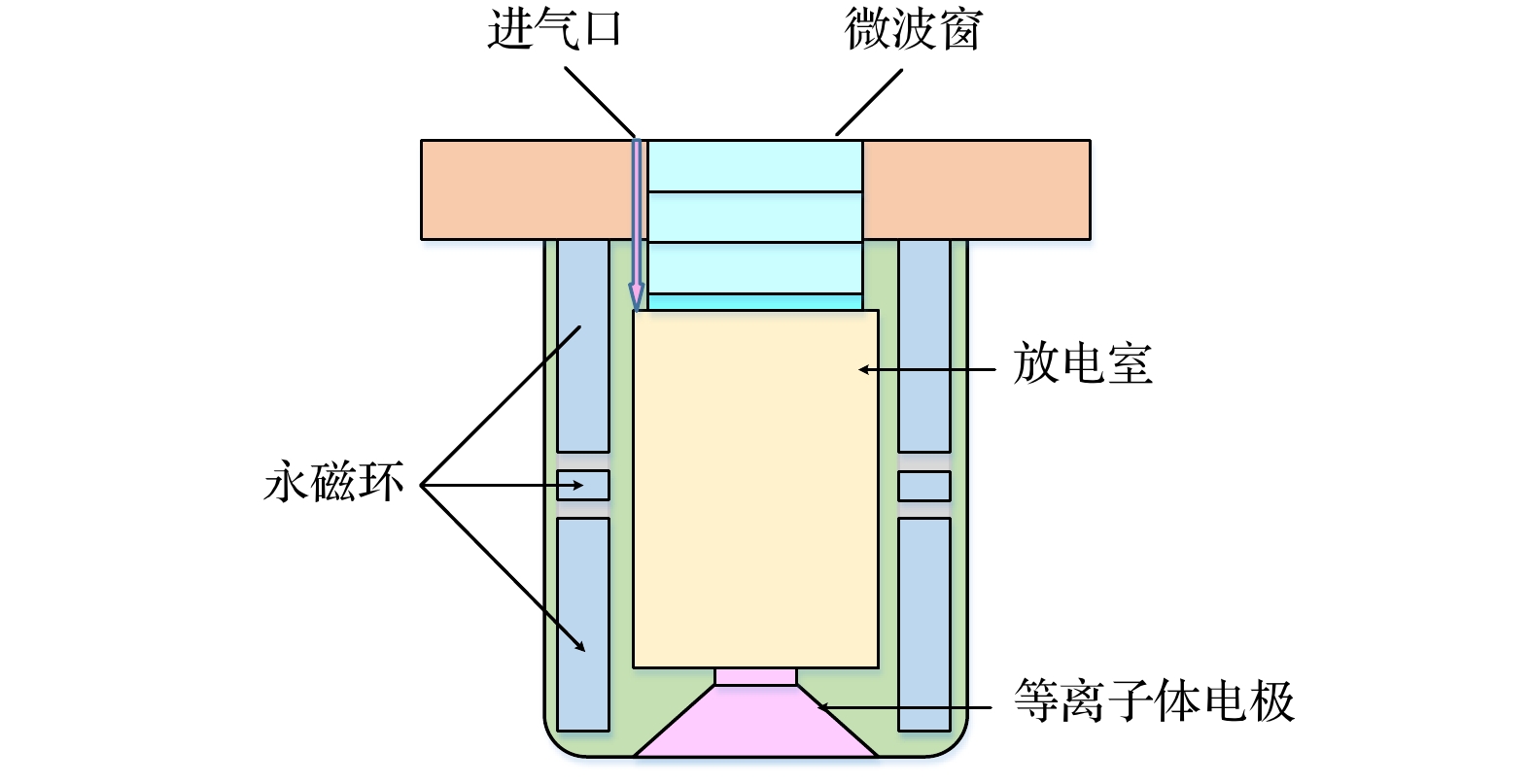
 下载:
下载:
